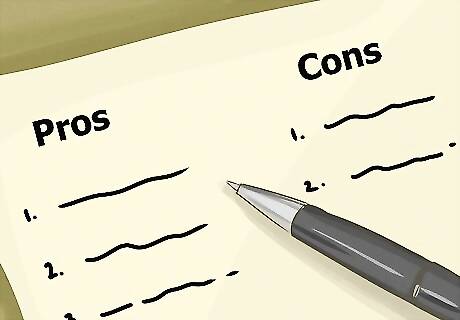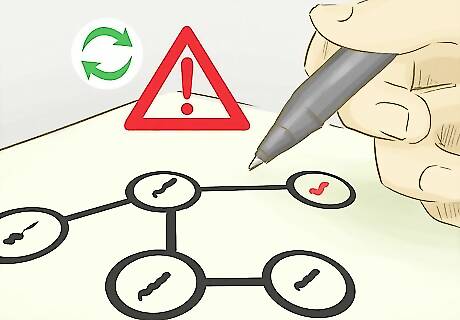
views
- Identify your problem by outlining what you already know about it, uncovering the information you're still missing, and finally, researching the missing information.
- Communicate the problem by writing it out, adding details, workshopping it with others to make it clearer, and if you're presenting your problem, identifying key terms.
- To solve the problem, try looking for causes, making a pros and cons list, and finally, identifying areas that you could fix.
Gathering Information About the Problem

Ask “why” to get to the heart of the problem. Asking “why” is a good way to delve deeper into the problem. Keep asking “why” until you can’t think of anything else to say about the problem. This works well in a group setting, but you can ask “why” on your own as well. For example, if you are searching for a new apartment, then you could start by asking, “Why do I need a new apartment? Because my roommate is leaving, I can’t find a new roommate, and I can’t afford this apartment on my own.” To gather more information on child hunger in your community, you might follow this line of questioning, “Why are children in this community going hungry? Because their parents are running out of money towards the end of the month. Why are they running out of money? Because their food benefits renew at the beginning of the month.”

Identify what you already know about the problem. Write down as much as you know about the problem. If you are working with a group of people to define a problem, then have everyone in your group do the same. You can list the information you know or write it in full sentences. For example, if you are in need of a new apartment, write down the specifics of the new apartment you need, such as when you need to move in, how much you can pay in rent each month, and where the apartment needs to be located. If you are trying to define the problem of child hunger in your community, then you might make a list that includes the estimated number of children affected, the areas where these children live, and where the children attend school.

Figure out what other information you need. After you list what you know, think about what you do not know. This is crucial for developing a comprehensive definition of the problem and also for working towards a solution. If you are working in a group to define the problem, talking about what information you need may be helpful. For example, if you are looking for a new apartment, then some of the information you might need could include your maximum rent per month, local apartment complexes, and the cost of utilities without a roommate. If you are trying to define the problem of child hunger in your area, then you might need to know how much extra food each family needs, what the shortage is in their benefit checks, and if they have any other sources of food.

Do research to fill in the gaps. Try searching online for the information you need. If that does not turn up the results, then you may need to make phone calls, design a survey, or consult an expert to get the information you need. For example, if you are trying to find an apartment within a specific area and price range, visit the apartment complex’s website, check your local newspaper for apartment listings, or call a local complex and ask questions. If you are trying to find out why the children in your community are dealing with hunger, talk with someone from the local food bank or create a survey for parents to complete.
Putting the Problem into Words

Describe the problem in your own words. Start by writing down the problem in your own words using as much detail as possible. Be as specific as possible in your description. For example, if the problem is that you need to find a new apartment because your roommate is moving out, then you might write it as, “I need to find a new apartment because I cannot afford to live in a 2 bedroom apartment on my own and I haven’t been able to find a new roommate.” Another example might be, “Children in our community are going hungry towards the end of the month.”

Expand your initial statement with more details. Add to your initial description of the problem using the information you have gathered. Include as many details about the problem as you can in your description. For example, if you are seeking a new apartment, then your tentative statement might be, “I need to find a new apartment by the end of the month because I can no longer afford this one. I need to find a 1 bedroom or studio apartment in the same neighborhood I live in now that costs no more than $700 per month.” If you are trying to define the problem of child hunger in your community, then you might write, “Children in this community are going hungry towards the end of the month because their parents are running out of money and food benefits.”

Discuss the statement to determine if it could be stronger. Talking through the problem statement in a group is a great way to determine if you have missed anything. Have an open discussion of the statement. Look for ways you could strengthen the statement and define the problem more clearly. If you are working with a group, ask your group members something like, “What else is missing from this statement? How could we make it stronger?” Work together to integrate the missing details.

Define key terms used in the problem statement. If you will be presenting your problem statement to a group of people, include the definitions of any key terms you use. Do this even if it seems like the terms are things that your audience will understand. For example, you might need to explain what is meant by “food benefits” in a problem statement on child hunger in your community.
Finding a Solution to the Problem

Look for patterns in the way people describe the problem. Talk to people who are affected by the problem. Read what other people have written about the problem. This may lead you towards a better understanding of what is causing the problem and possibly even a solution. For example, if you are looking for a new apartment because of the cost, you might notice that other people have run into a similar issue. This could help you to see that the high cost of living in that neighborhood is central to your problem. If you are trying to determine why children in your community are going hungry, read what other people have written about it. If a common theme is the distribution of food benefits, then this is likely central to the problem.

Check for possible causes of the problem. You may or may not know what has caused the problem. Either way, take some time to figure it out and write it down. There may be multiple causes that you should be aware of before you try to solve the problem. For example, if the high cost of a neighborhood is driven by the location and safety of the area, then these might be worth paying a little extra money for. Consider if you can find a way to work it into your budget, such as by cutting back on entertainment or another expense. If you are trying to define the problem of child hunger, then a possible cause might be a lack of access to affordable food in the community.

Determine what the consequences of the problem might be. Not working towards a solution to the problem could lead to far worse problems in the future. Take the time to consider the potential consequences of this problem continuing. Make a list of the pros and cons of the problem continuing to determine how you might tweak the negative aspects of it. In some cases, there may be more negative aspects of solving the problem than allowing it to continue. For example, if you try to stay in an apartment you cannot afford, then you may struggle from month to month and end up in an even worse financial situation later on. If the problem of child hunger is not solved, then children may suffer from malnutrition and psychological trauma, which could affect them for the rest of their lives.

Identify areas of the problem that you can change. You may not be able to solve the problem fully since many of its factors may be out of your control. Think about what aspects of the problem you are actually capable of changing. For example, if you cannot afford the rent for your apartment, you are not in control of the cost of rent. However, you may be able to find some ways to save or earn more money to stay in the same neighborhood. If you are trying to solve child hunger in your community, you may not be able to change the way families use their food benefits. But you can provide resources to help them or supplement their food supply when they run out.



















Comments
0 comment